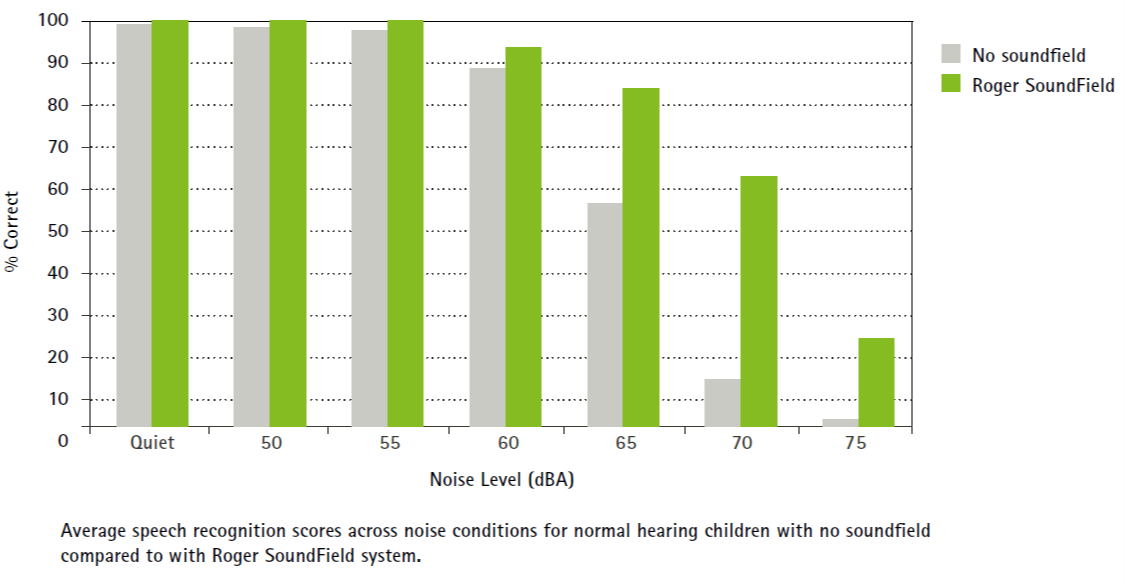
3 reasons why every classroom can benefit from a soundfield system
Read how a soundfield system can help make this next year successful for everyone in the classroom and the new features in Roger SoundField /V2.
All children require positive signal-to-noise ratios (SNRs) to learn. To understand speech in a noisy classroom, the speech signal needs to be higher than the noise signal. 1
Kids with hearing loss often get ear-level hearing technology (e.g., Touchscreen Mic) to help them hear speech in the classroom, but is that enough for ensuring students and teachers are well-equipped for the school year?
Research tells us that a soundfield system (which consists of a wireless microphone and one or more loudspeakers which amplify the teacher’s voice around the class) can provide benefits for children with and without hearing loss and their teachers.1-6
3 benefits of adding a soundfield system in a classroom
- All students in the classroom hear speech more clearly
With the addition of a soundfield speaker, the SNR increases for all listeners in the room, meaning all students are able to hear each other more clearly.
Adding a soundfield system provides significant speech-in-noise improvements for normal hearing children: up to 28% at 65 dBA of noise and 50% at 70 dBA over no soundfield.3.

In the chart, we see how speech recognition scores are significantly improved at sound levels at and above 65 dB (look at the distance between the gray and green columns at 65, 70 and 75 dBa). Not only will all the students in the class benefit from improved speech recognition scores when integrating a Roger SoundField speaker, but their use of the Pass-around mics will be positively reinforced, when they too can hear peers across the classroom.
A study in Nova Scotia, Canada investigated the effects of soundfield amplification systems on student class performance. It revealed that soundfield systems effectively increase the signal-to-noise ratio in classrooms and help children pay attention, hear and understand the teacher better.4
Other studies have reported improvements in reading and language scores for students in classrooms that use soundfield technology.1
This is especially important since children are still developing their attention and concentration, listening, learning and literacy abilities, as well as their behavior and self-esteem.
2. Teachers don’t have to strain their voice to be heard
Did you know that teachers need to speak approximately 15 dB louder than the background noise in the classroom, but this is rarely achieved throughout the day in a typical classroom? 6
When we stop to consider why this isn’t normally achieved it makes sense.
Classroom noise levels should not exceed 35 dB(A). However, typical classroom noise levels range from 41 to 51 dB(A).6
So this means that teachers need to be speaking at 56 to 61 dB throughout the day. It’s one thing to go to a noisy restaurant and speak loudly for a few hours, but every day, all day? That’s exhausting!
Noisy classrooms can result in teachers suffering from vocal strain – leading to poor vocal health in the long term and increased costs due to teacher absences.
A study in Brazil2 showed that using a Roger SoundField in a classroom, for just one period of the school day, was enough to improve dry throat symptoms, voice quality, fatigue while talking, and vocal strain in teachers.
3. Teachers can monitor the signal coming from a remote microphone
Even after using ear-level hearing technology for months, normal hearing teachers, may not realize how even little things can impact the sound for their students. For example, if the teacher’s lanyard is brushing against the Touchscreen Mic or the microphone is backwards, it could create sounds that are mildly distracting or unpleasant to the student.
A soundfield system allows for real-time monitoring of the system (by letting them hear the output regularly) so they can better understand how these actions impact the student.
Roger SoundField system – how it works
This system consists of the wireless Roger Touchscreen microphone and the Roger DigiMaster loudspeaker. Here is how it works:
- Typically worn around the neck, Roger Touchscreen Mic sends the voice from the teacher to the Roger DigiMaster loudspeaker which is positioned in the classroom. The Roger Touchscreen Mic continuously estimates the surrounding noise and automatically optimizes the volume so that speech remains loud and clear, for improved speech understanding.3
- The Roger Digimaster 5000 provides a 12-speaker array and a wide horizontal directivity. This results in less reflection than other systems and therefore, can provide clearer speech and sounds with ideal classroom coverage. It is easy to set up – just plug in and turn on.
- The Roger Digimaster 7000 provides a 15-speaker array and can cover larger classrooms. Two Digimaster 7000 speakers can be paired together to cover a space twice as big as one Digimaster 5000.
4 new features in Roger SoundField /V2
- Bluetooth connectivity: The new connectivity module makes it easy to simultaneously connect to multimedia devices. This allows the teacher’s voice from the Roger Touchscreen Mic to be mixed with music or another audio signal (e.g., from a smartphone).
- Upgraded loudspeakers: Fuller, richer sound quality and more bass, thanks to new transducers and seal.
- Output jack: This connector allows teachers to record lessons when needed for absent students, staff meetings, and/or evaluation purposes.
- USB connector: Firmware upgrades are available through the USB connector, making it easy to upgrade whenever it’s needed.
What does this mean for students and teachers? A soundfield system significantly boosts a student’s chance for academic success by providing an improved acoustic environment for listening and learning. Teachers also benefit as the increased SNR reduces risk of vocal disorders related to vocal strain.
Click on the links below to learn more:
- Overview and support literature on Roger SoundField solutions
- Phonak Compendium: A review of soundfield amplification systems
- Blog post on the impact of noise in the classroom
- Video and sound demo
Are you interested in adding a soundfield system to your classroom(s)? Your Phonak rep can work with your instructional media team, educational audiologists, or the purchasing department.
References
- Bennett-Long, A. (2001). The effects of soundfield amplification on reading achievement. Valdosta State University. Retrieved from http://citeseerx.ist.psu.edu, accessed July, 28, 2022.
- Cruz, A. D. da, Silvério, K. C. A., Ribeiro, V. V. & Jacob, R. T. de S. (2016). Dynamic soundfield system impact on the teacher’s voice: case report. Revista CEFAC, 18(5), 1260–1270.
- Wolfe, J., Morais, M., Neumann, S., Schafer, E., Mülder, H., Wells., N., John, A. & Hudson, M. (2013). Evaluation of Speech Recognition with Personal FM and Classroom Audio Distribution Systems. Journal of Educational Audiology, 19, 65-79.
- Boothroyd A (1997). Auditory development of the hearing child. Scandinavian Audiology, Supplemental, 46, 9-16.
- Langlan, L.A., Ravichandran, S., Caissie, R., Kreisman, B.M. (2009). The benefit of soundfield amplification in First Nations elementary school children in Nova Scotia, Canada. The Australian and New Zealand Journal of Audiology, 31(2), 55–71.
- Neuman, A.C., Wroblewski, M., Hajicek, J., & Rubinstein, A. (2010). Combined effects of noise and reverberation on speech recognition performance of normal hearing children and adults. Ear & Hearing, 31(3), 336–344.
